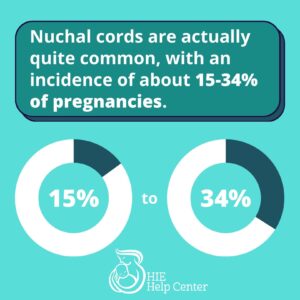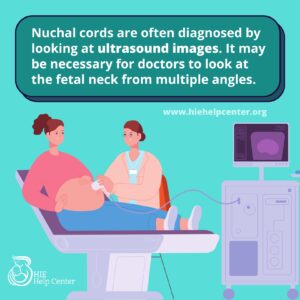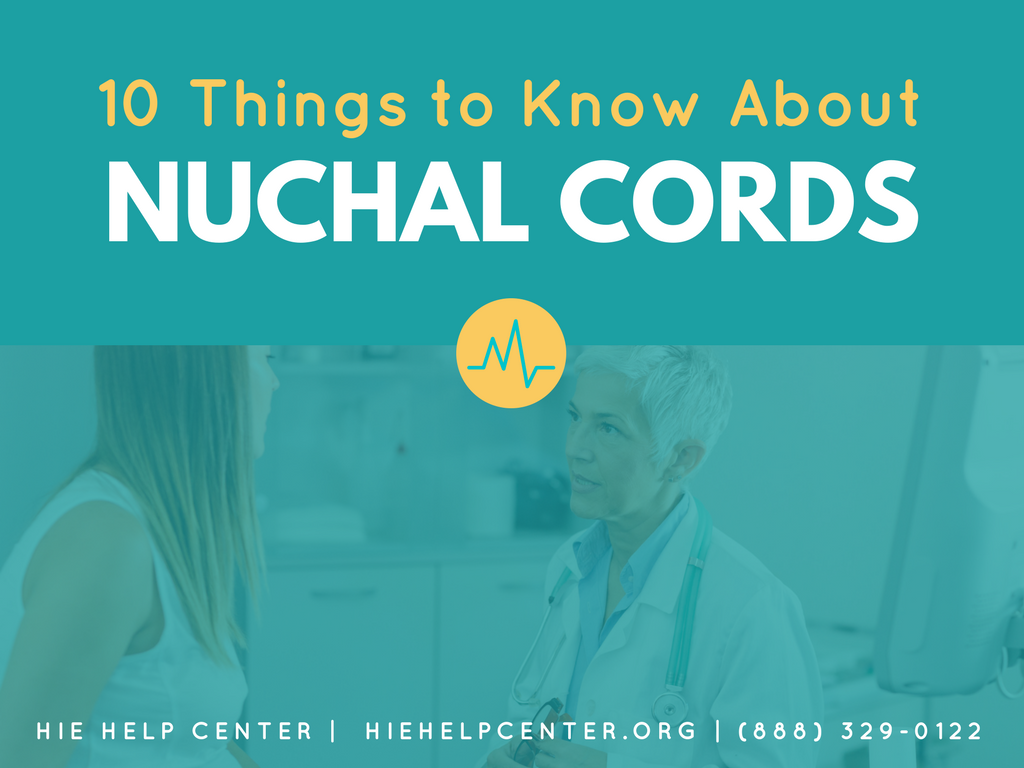The information presented above is intended only to be a general educational resource. It is not intended to be (and should not be interpreted as) medical advice. If you are pregnant and have questions about management of a nuchal cord, please consult with a medical professional.
1. The term “nuchal cord” refers to a condition in which the umbilical cord is wrapped around the fetus’s neck.
An official diagnosis of “nuchal cord” only requires 75% of the neck to be wrapped by the cord. Sometimes, 360-degree imaging in utero may not be possible.
2. There are three ways of classifying nuchal cords:
- First, based on how many times the cord is wrapped around the fetal neck. This can mean wrapped around once (single nuchal cord) or twice (double nuchal cord).
- Second, whether it is wrapped loosely or tightly. A “tight” nuchal cord is defined as one that cannot be slipped over the baby’s head during delivery, and may compress the fetal neck.
- Third, the nuchal cord can be Type A or Type B:
- A Type A nuchal cord is “unlocked.” The umbilical end goes under the placental end, and fetal movement can easily undo it.
- A Type B nuchal cord is “locked.” The placental end of the cord goes under the umbilical end of the cord, potentially leading to another type of umbilical cord complication known as a “true knot.” This will not likely be resolved by fetal movement.
 3. Nuchal cords are common.
3. Nuchal cords are common.
At term, incidence estimates have ranged from 15 – 34%. Most of these babies are born healthy, so it may be tempting to dismiss nuchal cords as a cause for concern. However, many of these babies have nuchal cords that resolve on their own prior to delivery, or are loose enough that doctors can easily maneuver away from the neck. Infants with nuchal cords that are wound tightly, wrapped more than once around the neck, or “locked,” are at greater risk.
4. Nuchal cords can cause oxygen deprivation/asphyxiation.
The cord essentially strangles the fetus, causing restriction of carotid artery blood flow and/or venous congestion. Alternatively, the umbilical cord itself becomes compressed (against itself or the fetus’s neck), preventing flow of oxygenated blood through the umbilical cord vessels.
5. Nuchal cords are more likely to occur if the umbilical cord is very long, or if the fetus is especially active.
Long umbilical cords are more likely to become tangled around the fetus, potentially resulting in a nuchal cord. However, unusually short cords can cause other types of pregnancy complications. Likewise, especially active fetuses are more likely to end up with their umbilical cord wound around their neck.
A lack of or decrease in fetal activity is a sign of fetal distress. Although fetal inactivity will not cause a nuchal cord to form, the reverse causation is definitely possible: if a nuchal cord cuts off oxygen supply, the baby may become less active.
 6. To see a nuchal cord, it is important for physicians to take ultrasound images from multiple angles.
6. To see a nuchal cord, it is important for physicians to take ultrasound images from multiple angles.
Otherwise, a nuchal cord may be misdiagnosed as fetal skin folds, amniotic fluid pockets, posterior cystic neck mass, or even a cord that is simply near the fetal neck but not encircling it. Color Doppler imaging is also more accurate at detecting nuchal cords than grey-scale ultrasounds.
7. Just because there is a nuchal cord early in pregnancy does not mean that it will still be there at-term.
Nuchal cords may form, become undone, form again, etc. If the nuchal cord is “locked,” however, it will not become undone.
8. Near delivery, appropriate management of a nuchal cord depends on tightness and fetal condition.
If a nuchal cord is loose and the fetus is not showing signs of distress (an abnormal heart rate, lack of movement, etc.), medical professionals may be able to slip the cord over the head during delivery. It may also be possible to move the cord down over the shoulders and deliver the baby through the loop. If the head has already been delivered and the cord is too tight to slip over the head or shoulders, doctors may attempt a “somersault delivery.” They push the baby’s head toward the mother’s thigh (as opposed to pulling the baby straight down). This allows the shoulders and the rest of the body to be born in a somersault, and keeps the neck near the birth canal so that the nuchal cord is not stretched and further tightened. They can then unwrap the nuchal cord.
If this maneuver is unsuccessful, they may have to clamp and cut the cord earlier than is generally recommended. This can put the fetus at risk of anemia and other problems. In cases where a tight nuchal cord is diagnosed prior to delivery, especially if there are accompanying signs of fetal distress, medical professionals should order an emergency C-section. Not doing so would be negligent.
9. Improperly managed nuchal cords can cause serious harm to the baby.
Nuchal cords can disrupt the flow of oxygenated blood to the baby, potentially resulting in birth asphyxia and hypoxic-ischemic encephalopathy (HIE). Nuchal cords can also lead to conditions such as cerebral palsy, seizures, intellectual and developmental disabilities, and more. In particularly severe cases, nuchal cords can even cause fetal death.
10. Immediately after a baby sustains an hypoxic-ischemic injury because of a tight nuchal cord, it is still possible to minimize brain damage.
A treatment known as therapeutic hypothermia, also sometimes called “cooling therapy,” can allow infant brains to recover after an oxygen-depriving injury. Although hypothermia therapy is not a complete cure, it has been shown to significantly reduce the extent of brain damage that infants suffer after birth injuries. Medical professionals should know that after an oxygen-depriving insult, quick administration of hypothermia therapy is essential. Failure to order this may constitute malpractice.
Should I call an attorney?
The HIE Help Center is run by ABC Law Centers, a medical malpractice firm exclusively handling cases involving HIE and other birth injuries since 1997. If you suspect your child’s nuchal cord injury may have been caused by medical negligence, give us a call to learn about pursuing a case.
We provide free legal consultations, during which we will inform you of your legal options and answer any questions you have. Moreover, you would pay nothing throughout the entire legal process unless we obtain a favorable settlement.
Source
Schaffer, L., & Zimmermann, R. (n.d.). Nuchal cord. Retrieved July 16, 2024, from https://www.uptodate.com/contents/nuchal-cord



Leave a Reply
You must be logged in to post a comment.